See, Believe, Buy: The Selling Power of Social Proof


See, Believe, Buy: The Selling Power of Social Proof
Get The Print Version
Tired of scrolling? Download a PDF version for easier offline reading and sharing with coworkers.
A link to download the PDF will arrive in your inbox shortly.
The ways people find, research, and purchase products have evolved drastically over the last few decades.
Social media has become the new print ads, review sites have become the new product vetting venues, and ecommerce sites are the new storefronts. There are myriad places where shoppers can enter, exit, and re-enter today’s path to purchase, with new on and off ramps popping up all the time.
So much about how we shop has changed — everything, that is, except the power of social proof.
What is Social Proof?
Social proof is the notion that people follow the actions of others.
Studied by psychologist Robert Cialdini, the theory of social proof states that when a person does not know what the proper behavior is for a certain situation, they will look to what other people are doing to conform their actions. As Cialdini’s book states, “we view a behavior as more correct in a given situation to the degree that we see others performing it.”
Put another way, what we see others purchasing impacts what we purchase.
Principles of Social Proof
The theory of social proof is built around three core principles: uncertainty, similarity, and expertise.
1. Uncertainty.
New or unfamiliar situations tend to cause a level of uncertainty and doubt in people. When people are unsure of how to behave or which actions to take, they often feel the need to look to others for guidance.
2. Similarity.
People are usually more inclined to follow the actions of those they view as similar to themselves when making novel decisions in a group setting. They think: if the people who share my background, needs, beliefs, or circumstances are taking these actions, then I should too.
3. Expertise.
When in unfamiliar situations, people often also seek guidance from people and organizations they view as experts in the space. Logic dictates that people with more knowledge make more informed — and therefore better — decisions.
Social Proof by the Numbers
Social proof works! And the data proves it.
82% of Americans seek recommendations from friends and family before making a purchase, but it’s not just recommendations from people they know that hold weight with shoppers. Most people (70%) will trust a recommendation from someone they don’t even know.
Oftentimes, these recommendations come in the form of social media. Whether it’s a Facebook or LinkedIn post, a tweet or a YouTube video, 87% of people say social media posts help them decide what to buy. And buy they do!
According to Hubspot, people are 71% more likely to make a purchase based on referrals they’ve seen on social media platforms.
But it’s not just social posts that sway shoppers. Ratings, reviews, and visual user-generated content (UGC) are also very influential. In fact, online conversions increase 133% when mobile shoppers see positive reviews before buying, and 79% of people say UGC highly impacts their purchasing decisions.
Word-of-Mouth for the Digital Age
The main principles behind social proof can also be found in word-of-mouth marketing (WOMM).
Word-of-mouth marketing — an oral or written personal recommendation by a satisfied customer to prospective customers — has long been one of the most valuable forms of advertising a brand can receive.
Why? Because it’s a genuine, third-party endorsement. It’s not coming from the brand or someone they paid; it’s coming from a real customer who had a positive experience and is therefore viewed as the most trustworthy form of promotion.
In fact, Nielsen Research found that 92% of consumers say they trust earned media, such as recommendations from friends and family, above all other forms of advertising.
As our forms of communication have changed over the years, so have the forms that WOMM has taken.
Today, word-of-mouth recommendations can be found in written reviews and rating as well as on social networks in the form of user-generated images and videos. And these types of influential content have been proven to drive sales across industries.
Using Social Proof to Increase Conversions
When shopping online, you can’t physically see, touch, or experience the items or services you’re contemplating purchasing before you buy them. This is why written and visual social proof has become so important to ecommerce brands. Featuring social proof across your ads, website and emails can help move online shoppers from inspiration to consideration and from consideration to purchase, ultimately driving conversions on your ecommerce site.
In fact, 79% of people say that social proof, like user-generated content (UGC), highly impacts their purchasing decisions.
Different Types of Social Proof
Consumers often turn to a variety of sources for social proof; some are more traditional, like celebrity endorsements and expert proof, while others have grown in popularity with the rise of social networks and ecommerce sites, like user-generated content and rates and reviews. Here are some examples of social proof:
1. Celebrity endorsements.
Although celebrity endorsements are probably the most well known type of social proof, they have evolved over the years. While celebrities still do TV, print ad, and billboard endorsements, it’s become more commonplace in recent years for their official support to come in the form of paid social media sponsorships, where (for the right price) a celebrity will share a post encouraging their social audiences to purchase your brand’s products or services. Regardless of the form these endorsements take, it’s important to choose a celebrity that is relevant to your brand and respected by your audiences in order for it to be effective.
2. Expert proof.
As we’ve already established, people look to experts when they’re uncertain in their decisions. This is especially true when making big ticket purchases like homes, cars, computers, fitness or sporting equipment, etc. By featuring content from trusted experts in your industry, you can bolster your credibility and provide the extra validation consumers need to move from ‘maybe I need it’ to ‘gotta have it.’
3. Customer reviews and ratings.
Online product reviews and ratings have emerged as an important form of social proof. Sites like Amazon, Tripadvisor, and Yelp have popularized the act of reviewing your purchases and experiences. In turn, today’s shoppers seldom make online purchases without referencing the ratings and user reviews of others. When was the last time you booked a hotel, went to a new restaurant, or purchased a novel item without first looking at what past guests and customers had to say?
4. User-generated content (UGC).
When it comes to social proof, seeing is believing. User-generated content is defined as any form of content — posts, images, videos, reviews, etc. — created by consumers on an online or social network. While product rating and reviews fall into this category, the most popular form of UGC today is visual content — aka the billions of photos, videos, boomerangs, etc. that people post on social networks everyday. Visual UGC has proven to be the most authentic, trusted and influential content to consumers.
5. Influencer endorsements.
Influencer marketing has become the new celebrity endorsement for our internet age. As people who have built their reputations and followings on social media platforms, they come with a built-in audience of enthusiastic fans to help grow awareness for your brand. Influencers tend to have specific niches — travel, fitness, beauty, mommy bloggers, etc. — so make sure you’re finding relevant, trustworthy creatives who reflect your brand ethos and are respected by your shoppers.
6. Testimonials.
As longer written forms of endorsements, testimonials can be very persuasive — particularly for pricier or intangible purchases like software. Don’t be shy about asking for testimonials from happy customers, then place these valuable pieces of social proof in prominent places on your website.
7. Badges.
If your company has ever won an award, received a certification or joined an association or partnership of note, you’ve probably been given a badge recognizing that accomplishment. Build credibility with site visitors by featuring these recognizable forms of social proof on your website.
8. Media logos.
Whether it’s an interview, profile piece or simply an article your brand is mentioned in, media coverage can be another form of crucial validation for uncertain buyers. Add an ‘as seen in’ section to your site to showcase any and all reputable publications your brand or products have been featured in.
9. Subscriber counts.
If your brand allows people to subscribe to your blog or newsletters, make sure to promote how many subscribers you already have. As we’ve established, people like to join in with the crowd, so let them know exactly how many people they’re joining by signing up.
10. Social connections.
By showcasing how many people are connected with your brand across various social platforms, you can demonstrate your existing credibility with broader audiences. Most of the top social platforms — Facebook, Twitter, LinkedIn — offer plugins that make it easy to feature these numbers on your ecommerce website.
11. Social shares.
Similar to social connections, it can go a long way towards proving your site’s popularity to display social share counts on social share buttons across each of your webpages. But beware: lower social share count can have the opposite effect, reducing trust in your brand.
Examples of Social Proof in Ecommerce
There are myriad ways brands can incorporate social proof into their ecommerce strategy. In fact, every stage of the buyer’s journey can benefit from the influence of social validation. From discovery and inspiration to consideration, purchase, and advocacy, social proof can help your brand improve performance and conversions.
Social ads.
Homepage.
Product page.
Community pages.
Transactional and promotional emails.
Social Ad Social Proof
These days, social media advertising is a key element of any successful ecommerce strategy. However, it can be hard to break through the noise on crowded social networks when the competition for scroll-happy consumers’ attention is high.
Visual social proof is an effective way to help your paid social ads stand out from the crowd.
Old Spice, for example, mixes expert content into their Facebook ads. By getting Dr. Corey L. Hartman to create sponsored content for their brand, Old Spice is able to provide extra credibility to the efficacy of the formula behind their grooming products.
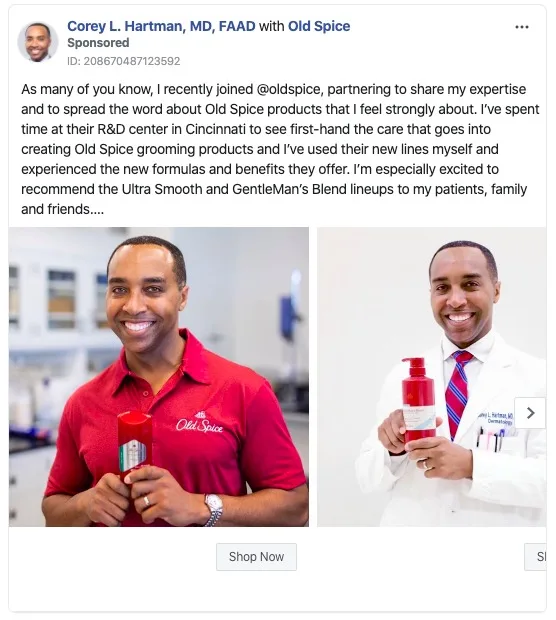
Homepage Social Proof
Your homepage is your brand’s digital storefront. To make a good first impression and inspire site visitors, showcase your best social proof on your ecommerce homepage.
Campman, a Utah-based outdoor gear brand, uses their online store’s homepage to highlight both written and visual social proof. Underneath their featured products, they display a visual UGC gallery of their customers putting their hiking and sporting gear to use while also encouraging others in their community to share their Campman adventures.
Directly below their UGC gallery, Campman also features top ratings and product reviews from real customers, pairing visual inspiration with the written social proof shoppers look for before buying.
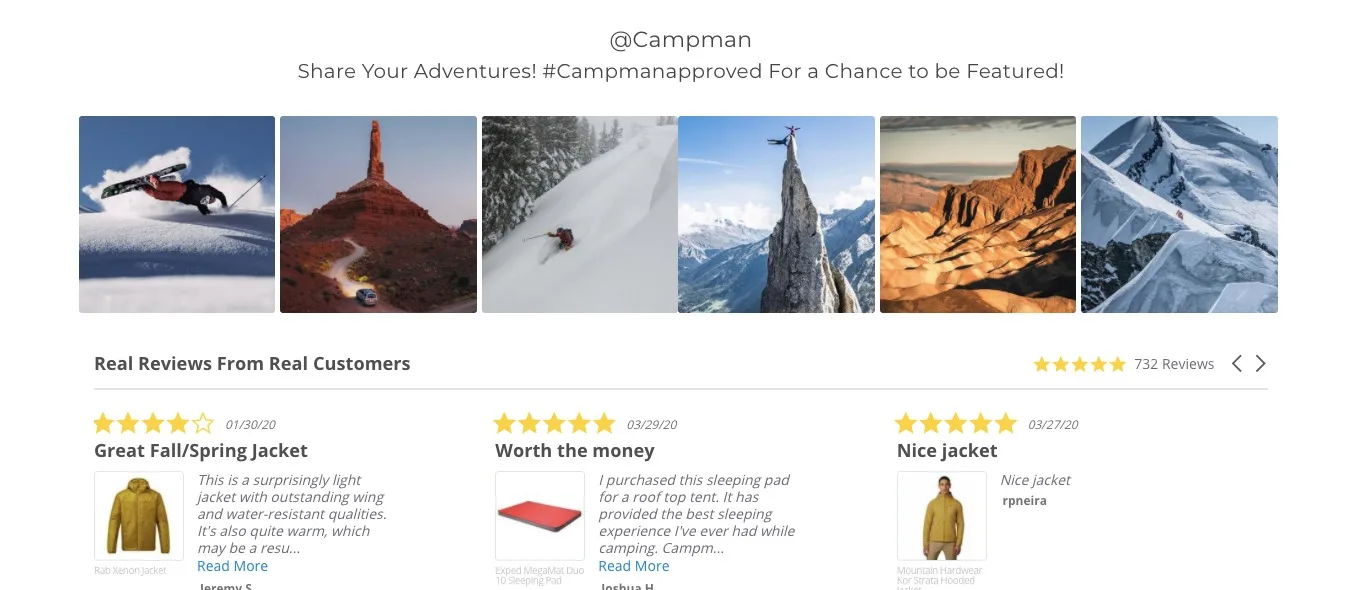
Product Page Social Proof
Did you know that customers are 6x more likely to purchase a product if the page includes pictures from social media? By thinking beyond your homepage to feature compelling and relevant social proof on your product pages, you can significantly boost online conversions.
Here are a variety of ways you can infuse your product pages with social proof:
Indicate how many people have already bought the product.
Emphasize customer testimonials, product reviews and ratings.
Display visual user-generated content of the product.
Display expert reviews or product awards.
A brand that has ticked all of these boxes with their product page design is Lush Cosmetics. Not only do they feature visual social proof on across their site, they have also made that inspiration content shoppable, taking people directly from a piece of UGC inspiration to its relevant product page for purchase.
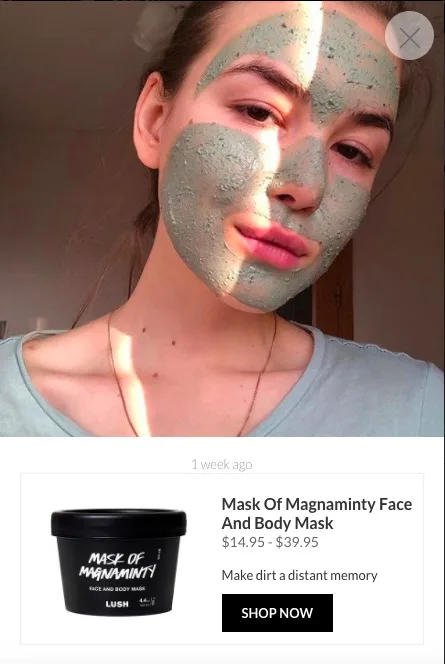
Once on the product page, visitors are immediately presented with the Mask of Magnaminty’s 4.6-star customer rating and a jump link to its 1400+ customer reviews.
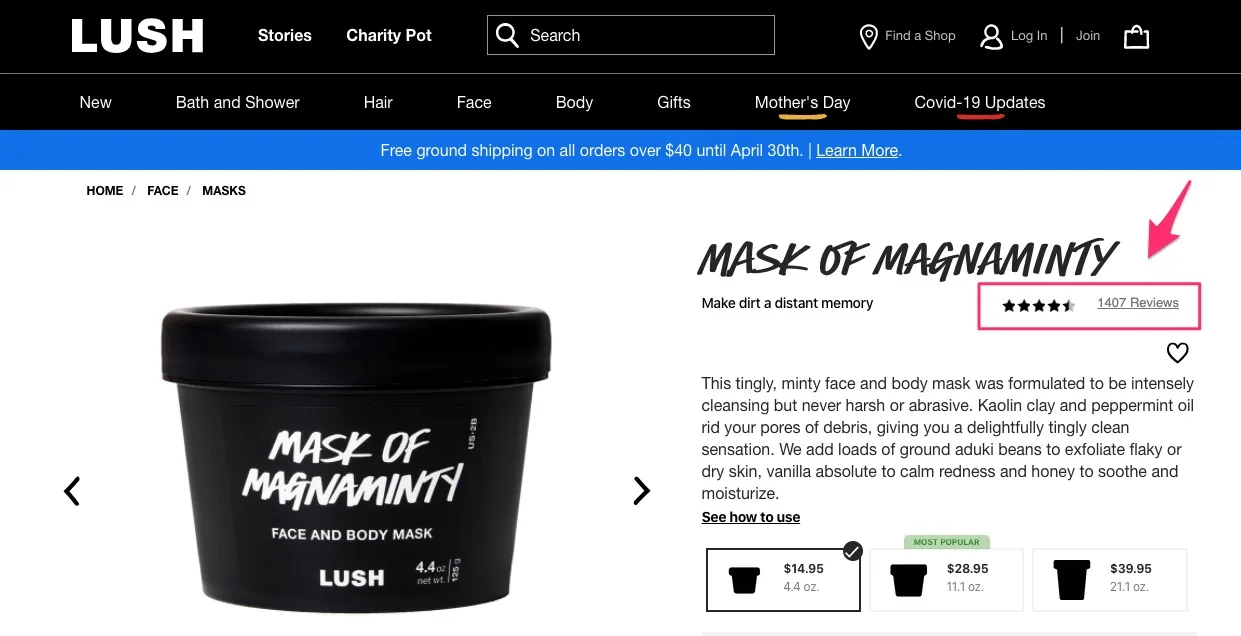
Upon scrolling further down the product page, shoppers will see written reviews from real customers, as well as a visual UGC gallery with photos of customers happily wearing their favorite Lush face mask. The UGC gallery has the added benefit of demonstrating the enthusiasm of the Lushie community as well as promoting Lush’s Instagram account for new fans to follow.

Community Page Social Proof
Your customers are your brand’s greatest asset. The more you do to turn your customers into passionate and loyal fans, the more successful your brand will be. To that end, a number of brands are now carving out special sections of their websites to feature content created by their community of customers and encourage others to join in the fun.
Tapping into the enthusiasm people have for their automobiles, Mazda has created a #DiscoveMazda page on their site asking owners to share their favorite Mazda stories — whether it be about their first Mazda or their favorite road trip. Giving Mazda owners the opportunity to share their car stories as well as connect with each other is a personal and powerful way to cultivate a vibrant and deeply loyal community.

Transactional & Promotional Email Social Proof
The impact of social proof doesn’t stop after payment. A successful omnichannel marketing strategy includes leveraging social proof to deliver more engaging and personalized emails as well. Incorporating UGC into transactional and promotional emails can help to build community, strengthen customer loyalty, reduce shopping cart abandonment and increase conversion rates.
Beauty and skincare brand Glossier has mastered the art of delivering emails with social proof. They keep their audiences engaged and their email performance high by featuring UGC throughout different types of outreach.
When a shopper signs up for their newsletter, they receive a welcome email with UGC gallery saying ‘See you on Instagram’; when a visitor has browsed a product page without completing a purchase, they promptly get an email reminder with social images of the products left in their carts; after a new product as been delivered, customers will get an email encouraging them to leave a positive review and post about their latest purchase.
All these communications reinforce a sense of community while personalizing the customer experience.

How to Ask for Social Proof
As the saying goes, you don’t get what you don’t ask for. Once you know which types of content your audiences respond well to, oftentimes all you have to do is ask your community to create it, and they gladly will.
Keep in mind: the more specific your ask, the more relevant the content your customers create will be.
1. Send requests for reviews after a customer purchase.
Since timing is everything, make sure to send customers requests for product ratings and reviews within a few days of their products being delivered. It will still be top of mind for them and hopefully the excitement of their new possession will motivate them to share their feedback. You can also drop in an incentive, like a 10% discount on their next purchase, for added encouragement.
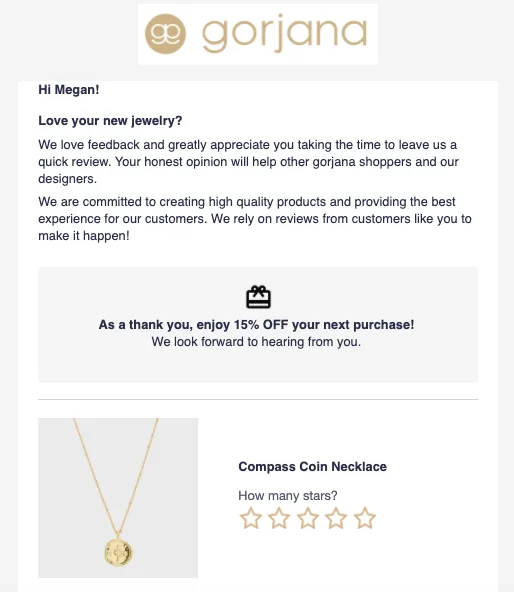
2. Email customers asking for visual UGC.
As we’ve learned, visual social proof is just as, if not more, convincing to prospective buyers as written social proof. Don’t be shy about asking your customers and social audiences to create visual UGC for your brand. Worried you won’t see high engagement? Make it fun by starting a social competition or giveaway that helps to gamify the experience.

3. Optimize your website to simplify review submission.
The less barriers to entry, the more likely people will take the actions you want. Make it as easy, accessible and as straightforward as possible for people to submit positive reviews, ratings and testimonials to your site. Reduce the amount of steps to submission, add calls-to-action on every relevant webpage and send follow-up emails so they can see and share their review with their social networks.
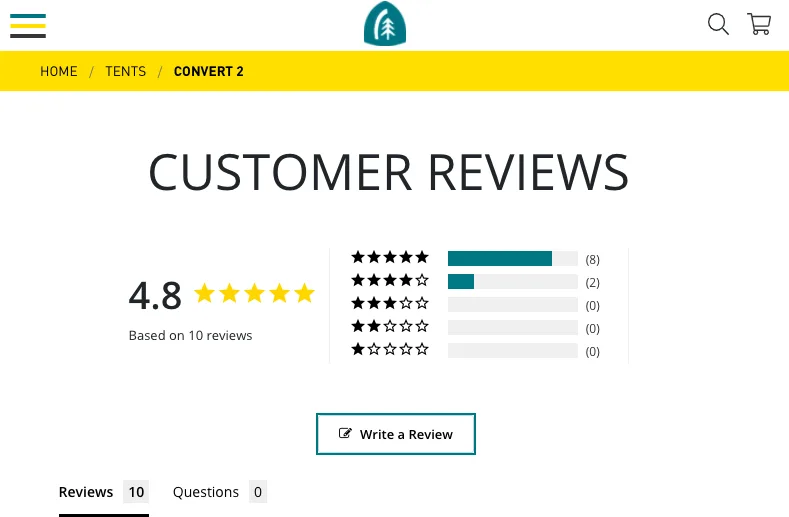
4. Create case studies about customer experiences.
If your brand is lucky enough to have passionate fans who enthusiastically share their positive experiences with you, directly engage with those customers. Reach out to them with an offer to make them a spotlight customer success story on your website and social media posts. They’ll be delighted your brand has recognized and acknowledged them, and you’ll get all the information you need — whether it be in the form of a written story, photo series, or video testimonial — to share that authentic social proof with new potential customers.

Executive Summary
These days, consumers have seemingly endless choices and paths to purchase, making social proof more important now than ever before.
Knowing that social proof can help move the needle at every stage of the buyer’s journey, start incorporating it into your brand’s ads, web pages, and emails. Try out different forms of social proof across different touchpoints and run A/B tests to hone in on which combinations of social proof resonate best with your audiences.
By leveraging authentic written and visual social proof along with the right calls-to-action, you can start quickly turning people from browsers into buyers.

Megan is Direct of Content & Communications at Stackla, the world's smartest visual content engine helping marketers save time and money by fueling all their marketing activities with authentic user-generated visuals that perform at every touchpoint. As a marketing and social media enthusiast, Megan has a passion for telling compelling stories that educate, engage and motivate audiences.


